English "Flowers" in the Caribbean
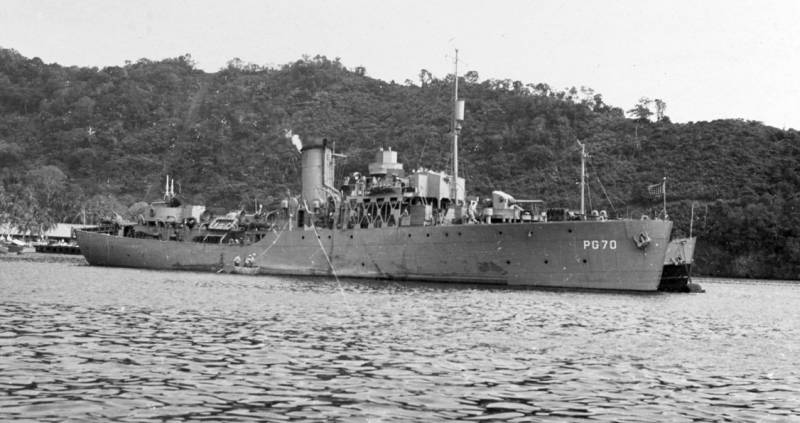
USS Courage (PG 70), ex-HMS Heartsease (K 15), moored somewhere in the Caribbean, 1943.
When Adolf Hitler declared war on the United States on December 11, 1941, the area of operations for the Dönitz wolf packs was expanded. Now they were ordered to operate also off the east coast of the United States, in the Gulf of Mexico and in the Caribbean Sea. The American armed forces in general and the US Navy in particular were not ready for such a development of events, from the word at all. Although the United States indirectly even took part in the Battle of the Atlantic (Neutral Patrols), the country had no experience in anti-submarine defense of its own territorial waters. In general, the anti-submarine defense system itself was practically absent, as well as specialized ships and aircraft.
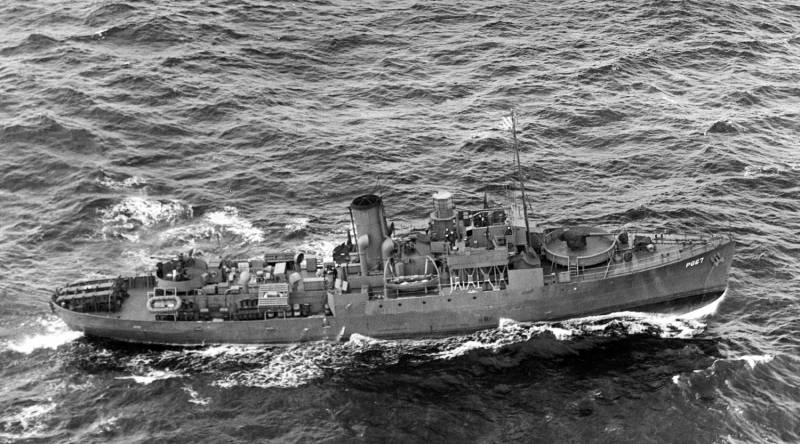
USS Ready (PG 67), ex-HMS Calendula (K 28), at sea in 1943 The anti-submarine armament of the gunboat is clearly visible - stock bombers and stern bomb releasers.
The beginning of 1942 fully showed the absolute unpreparedness of the United States to fight enemy submarines. February 1942 was a real black month for the Americans in this regard.
On February 16, 1942, it became clear that the Germans were active and very aggressive in the Caribbean. On this day, the submarine U-156 sank several ships and fired on coastal oil storage facilities in Aruba, U-502 sank several small tankers off the coast of Venezuela. Submarine attacks on 16 February were reported throughout the Caribbean. Real panic set in. A “wolf pack” of six German and two Italian submarines entered the Caribbean Sea ... And there was simply no one to resist them, there were simply no anti-submarine defense forces in the region.

USS Brisk (PG 89). On August 1, 1943, this gunboat, escorted by convoy NG-376 (New York - Guantanamo), attacked and drove away the German U-732 from merchant ships.
One of the first and most logical steps was the introduction of the convoy system.
It was supposed to eliminate or at least minimize the number of single ships moving in the Gulf of Mexico, the Caribbean Sea and off the US East Coast. The convoys were lettered according to the points of departure and arrival, for example, GN convoys went from Guantanamo to New York, NG were "return" convoys from New York to Guantanamo, TAG convoys Trinidad - Aruba - Guantanamo, GAT "return": Guantanamo - Aruba - Trinidad and so on.

USS Temptress (PG 62), lead ship of the Temptress class, ex-HMS Veronica (K 37), photographed in Port of New York Harbor, October 29, 1943. The ship arrived in New York on October 28, 1943 as part of the escort of convoy GN-91 (Guantanamo - New York).
In addition to simply gigantic organizational problems, there was another key point - escort ships. And who, in fact, will escort all these numerous convoys?
For these purposes, they began to attract everything that was possible, the few gunboats (PG - patrol gunboat) already available to the US Navy in that region, naval destroyers, ships of US allies in the region. But it was very wasteful to attract destroyers to escort convoys off the coast of the United States and in the Caribbean in 1942. These ships were needed in different theaters and for other tasks, but there were no other ships.
In addition, it was clear that a meeting with a large enemy surface vessel in these waters was unlikely, so a vessel was needed that could escort convoys and was specifically designed to fight submarines. But the US Navy simply did not have such vessels at that moment.
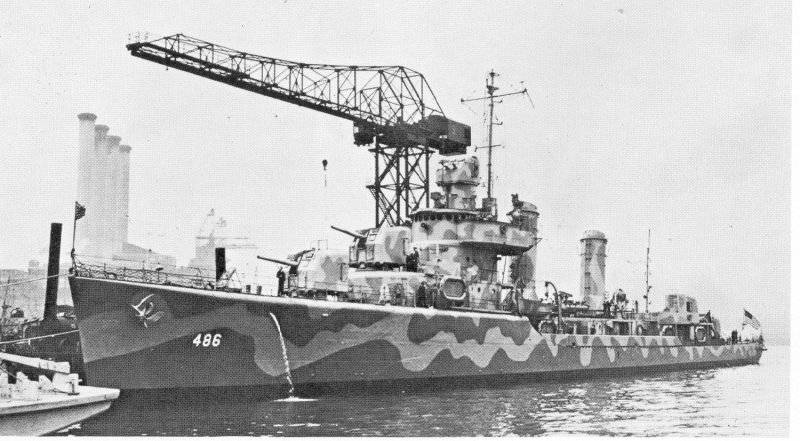
One of the heroes of the Battle of the Atlantic in the Caribbean, the destroyer USS Lansdowne (DD-486), photographed in 1942. On 13 July 1942 he sank U-153. The appearance at the end of the summer of 1942 of the former "flower" corvettes in the Caribbean made it possible to release such ships for alternative tasks. Already in September 1942, USS Lansdowne (DD-486) took part in battles in another theater of operations as part of Task Force 18 (TF 18).
I had to turn to the allies in the Anti-Hitler coalition, namely England.
Yes, it probably sounds even funny, but in 1942 the United States asked the British for ships. By that time, the British had been fighting the Battle of the Atlantic for several years, they had completely debugged the convoy system, and most importantly, they had a simple, cheap, efficient and very massive ship that met all the requirements of the Americans - a Flower-type corvette (Flower).
Having a rich experience of “relationships” with German submarines in the Great War, the British, entering the Second World War, understood that they would need a huge number of patrol ships, one of the main tasks of which would be precisely the fight against enemy submarines. In fact, something bigger and faster than a minesweeper was needed, and at the same time it was still quite cheap, which could be built even in small shipyards.
Smith's Dock Company offered its own version of such a ship, in theory it was a 700-ton armed whaler. The ship turned out, as it should have been, simple, cheap and at the same time proved its effectiveness. In total, according to the original and modernized project, almost 300 such ships were built during the war.

USS Spry (PG 64), ex-HMS Hibiscus (K 24), photographed in late 1943 from a US Navy airship K-84 escorting a convoy off the coast of Brazil.
True, the sailors who accompanied the convoys in the Atlantic on the "flowers" complained about the difficult conditions of service on a small ship during long passages across the ocean. The situation with the living conditions of the crew has become better on the ships of the improved design. But the Americans did not care much about this, firstly, they intended to sail on these ships mainly in the Caribbean Sea, and not cross the entire Atlantic (although later they had to do this as well), and secondly, the convoy routes were much shorter (although later this changed). And finally, the situation was from the category of "not to fat", the ships were needed here and now.
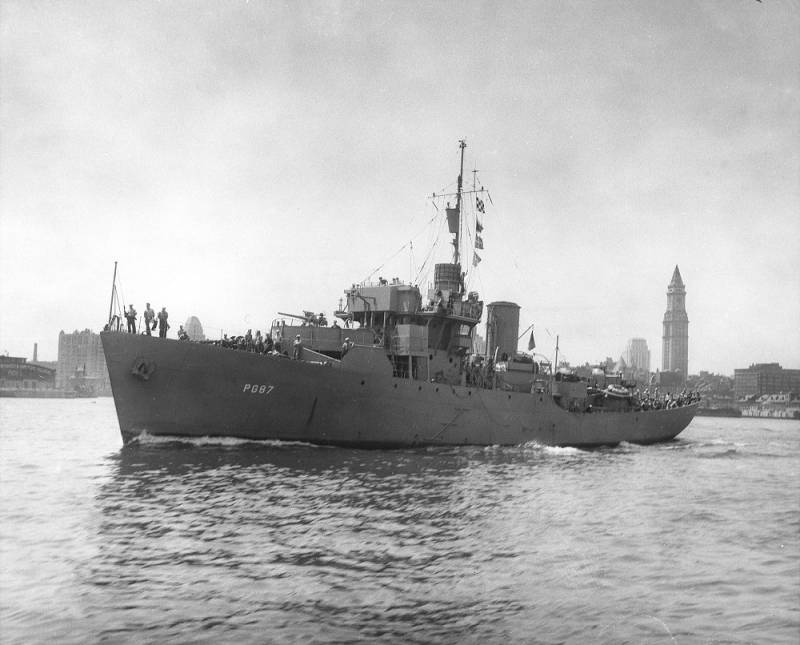
The gunboat Alacrity (PG 87) photographed from a US Coast Guard boat in the port of Boston in 1943.
The British undertook to transfer ten ships from the presence as a "reverse lend-lease". These were vessels already serving in the Royal Navy. navy, all of which were built at shipyards in England between the spring of 1940 and the spring of 1941. The first ship was transferred to the US Navy on February 16, 1942 (the day Black February began for Americans in the Caribbean), the last on May 2 of the same year. The ships received new proper names, the designation PG - patrol gunboat, and numbers from 62 to 71 inclusive.
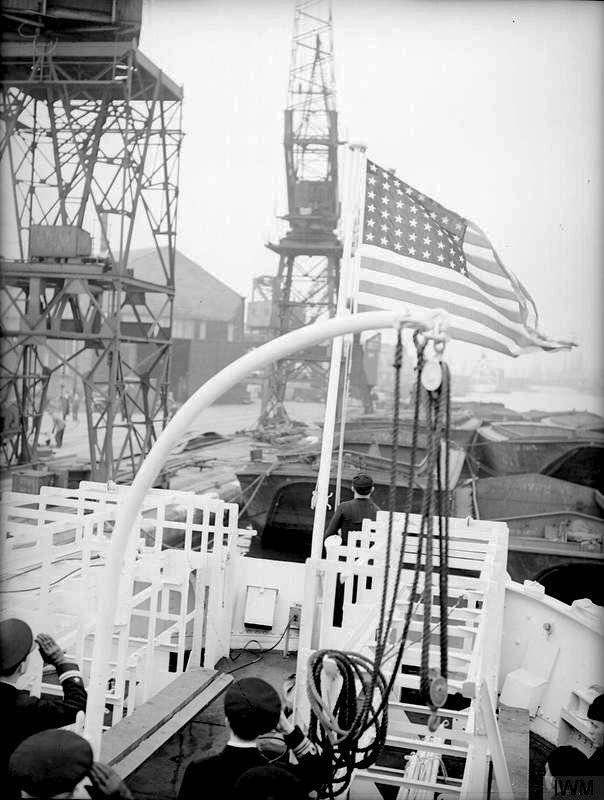
Flag-raising ceremony on the former HMS Begonia (K 66), now officially USS Impulse (PG 68), 16 March 1942, Liverpool. Now the ship will have to cross the North Atlantic and undergo repairs in the United States.
In addition, the Americans ordered the construction of another 15 ships at shipyards in Canada. By that time, the country had become a real forge of PLO ships for Great Britain. The 15 already laid down ships of the improved Flower project were to be completed according to American requirements and transferred to the US Navy. True, the Americans accepted only 8 ships into the fleet, which were commissioned from November 22, 1942 to August 16, 1943. Another 7 ships, completed in the interests of the US Navy in 1943, were transferred to the Royal Navy right on the day of acceptance by American sailors. These ships were transferred to the British already as American property under the lend-lease program and at the end of the war returned to the American fleet.

USS Surprise (PG 63), ex-HMS Heliotrope (K 03), photographed escorting a convoy to Greenland on 1 July 1944. The ship was repaired in May 1944, which is noticeable by the new mast, moved behind the wheelhouse, and somewhere under these blocks of ice there should be a Hedgehog bomber. The ship had an interesting post-war fate. In 1947 it was sold to the Kuomintang, but in 1949 it ended up in the hands of the Chinese Communists.
Already combat-ready ships received from the British did not immediately go to sea under the new flag, they first went to the New York and Norfolk naval shipyards. The ships were to be equipped with American weapons and equipment.
The main changes were to replace the 4-inch British Mk. IX with an American one of the same caliber, replacing the 40mm Vickers Mk. 2 (the Americans were already well aware of its mediocre combat performance) with a 3-inch universal gun, the installation of two 20-mm Oerlikon assault rifles and the replacement of the British surface search radar with the American SG microwave radar.
There were dozens of smaller changes, such as:
– installation of new boxes for ammunition;
- installation of holders for American-style lifeboats;
- alteration of ventilation hatches in the engine room;
– new stoppers of anchor chains;
- installation of American-style spotlights;
- alteration of the foremast, etc., etc.

Photo of USS Tenacity (PG 71), ex-British HMS Candytuft (K 09), taken June 26, 1942 by an employee of the New York Navy Yard, for inclusion in the report on the work carried out on the ship.
Ships of an improved design, the Americans lost their 4-inch gun, it was replaced by another universal 3-inch gun, and most importantly, anti-submarine weapons were strengthened, a Hedgehog bomb (Hedgehog) appeared on the nose to the right of the gun. The bomber subsequently appeared on the corvettes transferred by the British from their fleet, in 1944 they were repaired and re-equipped.

USS Intensity (PG 93) of the improved flower design photographed at sea on September 9, 1943. A loaded Hedgehog bomb launcher is clearly visible to the right of the forward 3-inch multi-purpose gun.
At the end of the summer of 1942, the first ships began to leave the port of New York after completion and began to escort convoys. This made it possible to free some of the other ships, such as destroyers, from these tasks, and at the same time not to stop the escort of convoys. For the remainder of 1942, 1943 and 1944, the Temptress (US designation for the base Flower class) and Action (US designation for the advanced Flower class) class ships were involved in convoy escorting, primarily in the Caribbean, the Gulf of Mexico, and along the US Atlantic coast. Sometimes they were also recruited to work in other areas, such as escorting convoys to Africa or Greenland.

March 1943, USS Tenacity (PG 71) guarding a convoy bound for Casablanca.
The measures taken by the Americans gave results.
If in 1942 336 ships were lost in the Caribbean Sea, then in 1943 this number decreased by almost 10 times - to 35. In 1943, the Germans attacked convoys and even achieved success, sometimes they managed to catch a single ship almost off the coast, but all it was clear that in 1943 a radical front in the Battle of the Atlantic came, and in favor of the allies.
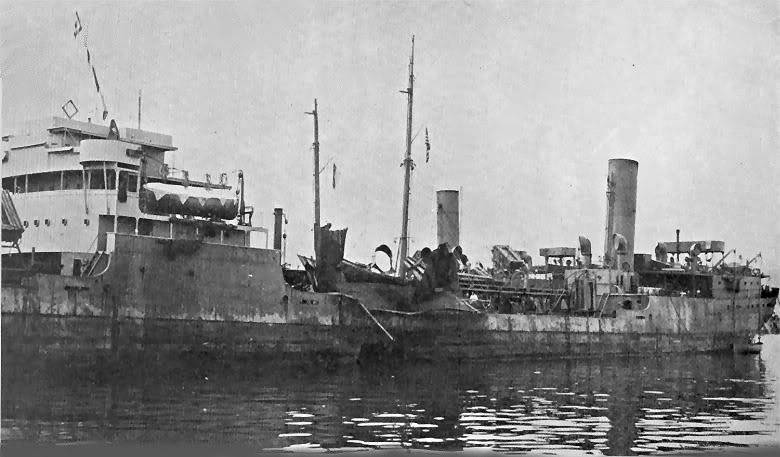
The tanker Esso Aruba, which received a torpedo hit during a German submarine attack on one of the TAG convoys in 1943. The ship remained in service and sailed as part of convoys in the Caribbean until May 1945.
In 1945, the American "Flowers" no longer led convoys, other ships appeared for this, and it was clear that the Battle of the Atlantic had already been won, the threat of submarine attacks was minimal. In 1944, only 3 ships were lost in the Caribbean Sea, in 1945, not a single one. Vessels performed patrol functions off the East Coast of the United States. In August 1945, 10 ships handed over by the British were returned to the Royal Navy. In 1946, the British returned the improved series corvettes transferred to them by the Americans, and the Americans themselves withdrew 15 ships of this project from the fleet in 1945–1946.
Ships were no longer needed immediately after the end of the war. They were a temporary measure, intended to "plug a hole" in the US anti-submarine defense and successfully completed their task, leaving their mark on the Battle of the Atlantic.

Quite a typical fate for the former "flower" corvettes. Many of them were sold to private owners after the war and lived out their lives as whaling, cargo or passenger ships. The former USS Impulse (PG 68), sold in the late 1940s to Spain, with the new name SS Rio Mero, sits aground near the Spanish city of Almeria. January 1970 In the same place, the ship will subsequently be cut into metal.
Information